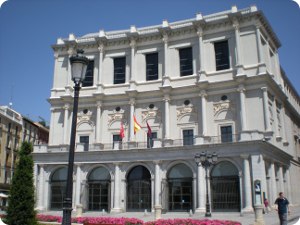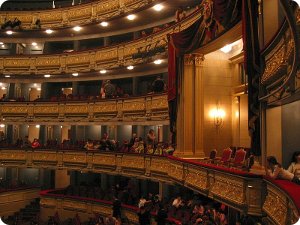Top Attractions
Royal Theater
 The Teatro Real, or Royal Theatre, is a major opera house located in Spain.
The Teatro Real, or Royal Theatre, is a major opera house located in Spain.
It is sometimes called "Opera Theatre" because it was the original name.
Situated between two squares, of Plaza de Isabel II (or "Plaza de Opera") and Plaza de Oriente.
The Theatre is located just in front of the Royal Palace, the official residence of the Queen Isabel II who
ordered the construction of the theatre in 1818. It was finally inaugurated on 19 November 1850, with a performance of
La Favorita by Gaetano Donizetti. The Queen called the splendid building "Opera Theater".
After thirty-two years of planning and construction, a Royal Order, on 7 May 1850, declared the immediate
termination of the "Opera Theater" and the building works are finished within five months.
From its inauguration in 1850 through to the present day, the theatre has been the subject of constant
alterations, political changes, construction problems and a succession of renovations. It has been the scene
of lyric productions but has also played host to parliamentary sessions and has even been used as a dance
hall during the last century and a half, a gunpowder store, a parliamentary debating chamber and was used as
an improvised barracks during the Spanish Civil War. Also suffered damage by the construction of the Subway
Network. When it reopened in 1997, it once again became, as Queen Isabel II originally intended it, the home
of opera in Madrid.
From 1868 the theatre's name was changed to "Teatro Nacional de la Ópera", regaining its "Royal" name with the
return of the monarchy in the person of Alfonso XII.
 Throughout the late 19th and early 20th centuries, Opera Theater garnered a reputation as one of Europe’s great
opera houses. It was especially well known for performances of operas by Giuseppe Verdi and
Wagner as well as
musical performances of great works by 19th century composer Stravinsky.
Throughout the late 19th and early 20th centuries, Opera Theater garnered a reputation as one of Europe’s great
opera houses. It was especially well known for performances of operas by Giuseppe Verdi and
Wagner as well as
musical performances of great works by 19th century composer Stravinsky.
It is difficult to identify any dominant architectural style at the Teatro Real, given the many restorations
and uses to which the building has been subjected. The first project, designed by López Aguado y Moreno,
settled for a hexagonal building with two façades. The main façade (historically reserved for the royal family)
is the circular one that dominates the Plaza de Oriente. The second and slightly less grandiose façade looks
out onto the Plaza de Isabel II.
With a seating capacity of between 1,748 and 1,854, depending on staging requirements, the theatre has 28 boxes
on its different floors, along with eight proscenium boxes and a Royal Box. The only floor devoted exclusively
to the general public is La Rotonda, which runs all the way round the building.
Directions:
Plaza Isabel II, S/N
28013 Madrid
Phone: +34 91 516 06 00
http://www.teatro-real.com/
* Lines 5 and 2 - Ópera station.

 Madrid Tourist
Madrid Tourist